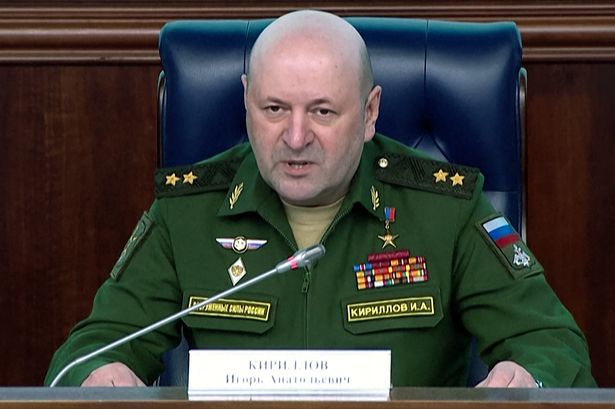The assassination of Lieutenant General Igor Kirillov, a prominent figure within Russia’s Ministry of Defense, has sent shockwaves through the Russian military and political landscape. Kirillov, 54, met a violent end on Tuesday morning when an explosive device, concealed within a seemingly innocuous scooter parked near his apartment building, detonated as he and his driver emerged from the premises. The blast claimed the lives of both Kirillov and his driver, instantly transforming a routine morning into a scene of carnage. While details remain shrouded in the fog of the immediate aftermath, the incident bears the hallmarks of a meticulously planned and expertly executed assassination, raising critical questions about the security apparatus surrounding such a high-ranking official and the potential implications of his death on the ongoing conflict in Ukraine.
Kirillov held a crucial position within the Russian military hierarchy, serving as the head of the Main Directorate for Rocket and Artillery Troops of the Ministry of Defense. In this capacity, he played a pivotal role in overseeing logistics and procurement for the Russian army’s artillery operations, a critical element of Moscow’s military strategy in Ukraine. This strategic significance makes his death a potentially debilitating blow to Russia’s war effort, potentially disrupting supply chains, hindering artillery effectiveness, and creating a vacuum in leadership within a crucial military department. Beyond the immediate tactical implications, Kirillov’s assassination also carries profound symbolic weight, demonstrating a concerning vulnerability within the Russian power structure and raising questions about the Kremlin’s ability to protect its high-ranking officials amidst an escalating conflict and growing internal tensions.
The circumstances surrounding the assassination highlight the sophistication and audacity of the attack. The use of a scooter as a concealment for the explosive device indicates a meticulous level of planning, suggesting the perpetrators possessed intimate knowledge of Kirillov’s routine and movements. This precision, coupled with the successful execution in a supposedly secure area, points towards a potentially well-resourced and highly trained operative or group. The method of attack also stands in stark contrast to the more conventional assassinations witnessed in the past, underscoring a shift towards more discreet and arguably more effective tactics employed against high-value targets.
The immediate aftermath of the attack has seen a flurry of activity from Russian authorities, with investigations launched to identify the perpetrators and determine the motives behind the assassination. While no group has officially claimed responsibility, speculation abounds regarding potential actors, ranging from Ukrainian special forces operating behind enemy lines to internal dissident groups within Russia. The Kremlin’s response, likely to be swift and decisive, will be closely scrutinized for any indications of the perceived culprits and the potential ramifications for Russia’s domestic and foreign policies. This assassination could escalate tensions both internally and on the international stage, potentially leading to increased security measures, heightened surveillance, and further deterioration in relations with Ukraine and its allies.
The reverberations of Kirillov’s assassination are likely to be felt across multiple spheres. Within the Russian military, the loss of such a key logistical figure will undoubtedly create disruption and necessitate a swift restructuring of leadership and operational procedures. This disruption could impact the flow of supplies to the front lines in Ukraine, potentially weakening Russia’s artillery capabilities and impacting the overall effectiveness of its military offensive. Furthermore, the assassination could fuel internal paranoia and distrust within the Russian power structure, prompting increased security measures and potentially leading to a crackdown on perceived enemies both within and outside the country.
Looking ahead, the fallout from this incident will be multifaceted and far-reaching. The investigation into the assassination will be closely watched, with its findings potentially having significant implications for Russia’s domestic and foreign policies. The incident could also serve as a catalyst for further escalation in the ongoing conflict in Ukraine, prompting retaliatory actions from Russia and potentially drawing other actors into the fray. Moreover, Kirillov’s death underscores the increasing complexity and volatility of the security landscape, particularly for high-profile individuals operating in high-stakes environments. The use of unconventional tactics and the apparent ease with which the perpetrators infiltrated a supposedly secure area raise serious questions about the effectiveness of current security protocols and the need for enhanced protective measures to safeguard against similar attacks in the future. The long-term consequences of this event will continue to unfold in the weeks and months to come, shaping the trajectory of the conflict in Ukraine and impacting the broader geopolitical landscape.














